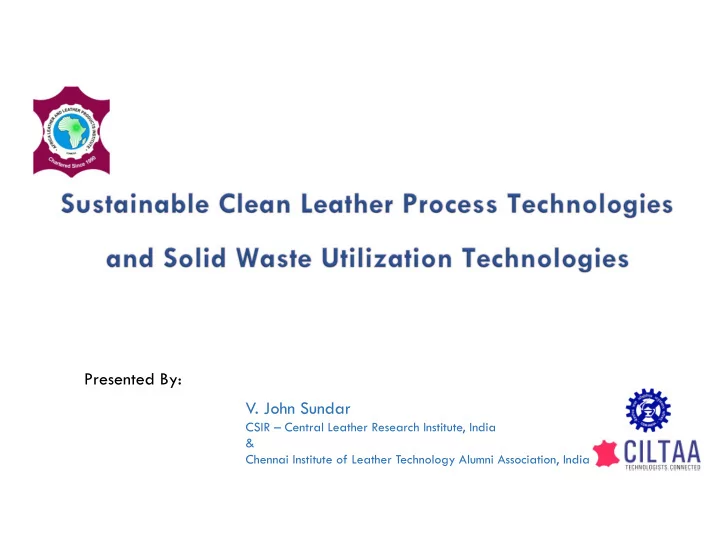

Presented By: V. John Sundar CSIR – Central Leather Research Institute, India & Chennai Institute of Leather Technology Alumni Association, India
INTRODUCTION
Environmental Implications of Leather Processing 50 m 3 liquid effluent containing Raw hide 1 ton COD 235 – 250 kg BOD 5 100 - 120 kg Suspended solids 150 – 200 kg Conventional Leather Chromium 5 – 6 kg making implicates Sulfide 10 – 12 kg generation of Solid wastes / By-products substantial amount of Untanned liquid and solid wastes Raw trimming 60 - 80 kg Fleshings 70 – 230 kg Tanned 200 kg Tanned splits 110 - 120 kg Shavings + Trimming 100 -110 kg Leather Dyed / finished 30 -- 35 kg Buffing dust 1 - 2 kg
Resources - Present Status & Needed Initiatives Raw material Energy Under Utilization Intensive Value Engineering Shift to renewable resources Chemicals Manpower Excess usage leading to economic Very low productivity loss and environmental concerns Skilling and strengthening of Substantive & eco-benign chemicals infrastructure Water Copious use - Need to conserve Water free / Low-float
Preservation Low Salt Preservation Green Fleshing Large quantities of salt used Less resource input Chlorides content in effluent exceeds Better opening up of skin matrix 60000 ppm Fleshings converted into valuable Chemical/Bio-additive assisted low salt products preservation developed Preservation with 20% salt + 2% soda ash/MgO Successful commercial trials Substantial salinity reduction Comparable leather quality
Beam- house Fibre Opening Enzymatic Unhairing Lime and sulphide free Replacement of lime with enzymes Cleaner pelts Process duration less than 1 hr Saving in water input (in drum) Suitable for all substrates Substantial reduction in BOD, COD, Sulphides and TDS Lime Splitting Flat & Firmer leathers Less chromium consumption Splits - Glue, gelatin, poultry feed
Conventional Tanning : An Assessment >85 % global leather production through chrome tanning 8 – 10% salt employed in pickling 7 – 8% BCS employed in tanning Exhaustion levels of 60% of Chromium is common Discharge levels of 80000 – 100000 ppm of chlorides & TDS and 5000 ppm of chromium not uncommon Poses serious environmental constraint Technical challenges to treatment systems Material and value loss
Chrome Management Use of new auxiliaries Change in leather characteristics & restrictions Pickle recycle Quality consistency, Handling difficulties and carry over of >30% salt Direct chrome liquor recycling Handling and operational difficulties and carry over of MOTOR MgO salt PLATFORM LEVEL RECOVERED CHROME CHROME TANNING DRUMS stirrer TO TANNING DRUMS SUPERNATANT TO DRAIN CHROME LIQUOR STORAGE TANK FLEXIBLE HOSE SUPPORT H SO Chromium recovery and reuse 2 4 CHROME SLURRY EXHAUST CHROME LIQUOR PUMP PUMP Screen Pickling issues not addressed, Increase in neutral salts REDISSOLVING COLLECTION TANK TANK discharge, Greater process control need PROCESS FLOW DIAGRAM OF CHROME RECOVERY AND REUSE SYSTEM
Salt free Tanning Technology Spent pickle tan liquor analysis Process TDS Chromium Chlorides (ppm) (g/lit ) (ppm) Salt free 6000 0.09±0.01 Nil Conventional 98800 0.62±0.01 84400±10 Successful commercial trials Saudi Arabia Srilanka Indian Tanneries > 100
Salt free Zero emission Tanning Technology - An overview Total elimination of common salt and mineral acid for pickling & tanning The technology uses only conventional tanning chemicals and does not call for use of any new chemical Affords reduction in tanning material input Significant reduction in process duration The technology is suitable for all substrates and product-mix Minimizes total dissolved solids in effluent Technology does not call for any change in infrastructure Leads to chromium exhaustion exceeding 90% in tanning The process ensures minimization of chromium discharges in post tanning operations
SIMPLE ECO - BENIGN SZCT Technology VERSATILE ECONOMICAL
Chrome Free Tannages Full Vegetable tanning / full organic tanning systems Tara, Oxazolidine, Organic phosphonium salts Combination of Vegetable – Acrylic / aldehyde Combination of Vegetable – Plant oils Suitable for diabetic footwear Safe & Durable Eco – benign Versatile
Post Tanning Avoiding REACH restricted chemicals Use of benign & safe chemicals Minimizing water usage Ensuring near zero chemical discharge by employing substantive chemicals
Water Management Use of optimized / rationalized volume of water Use of water meters / aqua mix system Recycling of spent liquors without treatment / recovery wherever possible (eg: liming) Segregation and management of sectional waste streams (eg: soaking) Modification of process to maximize absorption to make spent liquor suitable for recycling (eg: Better exhaustion of chromium)
Resource Management through Process Control Parameters controlled Hide float ratio pH Chemical preparation and mode of addition Benefits Duration Product consistency Temperature Minimum rejections Better manpower utilization Reduction in wastages
Keratinous Wastes - Hair Home furnishings - Rugs and carpets Hair protein as animal feed Keratin hydrolysate through alkali or enzymatic hydrolysis As exhaust aid in chrome tanning and rechroming During post tanning – for filling and retanning
Bio-Fertilizer Conversion of proteinous trimmings & fleshings Excellent nitrogen source Enriched with mineral P and K Biometric observations encouraging Employed as plant growth promoters
Poultry feed Syntan Limed fleshings rich in protein Enzymatic digestion of fleshings Hide fleshings mixed with carbohydrate Used as exhaustion aid in chrome tanning residues Used as Protein syntan As an animal feed additive - Provides food supplement amino acid CHARACTERISTICS VALUE Dry matter 38-40% CHARACTERISTICS VALUE Ash 8-9% Moisture 6-7% Protein 36-40% Total Ash 10-12% Yield 80-85% Crude Protein 22-30% pH range of application 2.5-8 Fibre 13-15% Ether extract 8-9% Molecular weight 5000 – 30000 kD Insoluble Ash 5-6%
Protein Syntan Chrome shavings constitute 40-50% of the solid wastes Hydrolysis under alkaline condition Chromium and collagen protein is separated Can be coupled with acrylics Leather filling and retanning agent
Leather Board – Tanned Wastes Used in Chrome/ Vegetable tanned shavings leather goods as supplementary; as insole in shoes; Pulp chappal uppers and Rubber latex as sound proofing material Coagulated mass Filter Sheet & Pressed Dried Leather board
THANK YOU
Recommend
More recommend